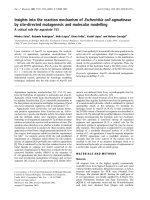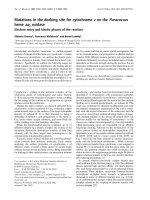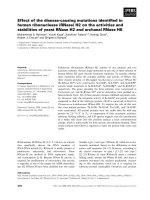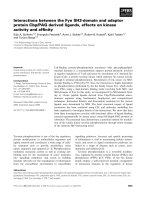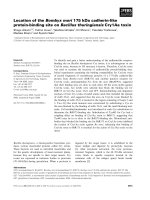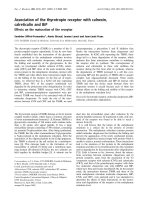Báo cáo y học: "Report on the Molecular Approaches to Osteoarthritis Symposium, Imperial College London, UK, 18–20 April 2004" docx
Bạn đang xem bản rút gọn của tài liệu. Xem và tải ngay bản đầy đủ của tài liệu tại đây (42.97 KB, 5 trang )
203
ADAM = a disintegrin and metalloproteinase; ADAMTS = a disintegrin and metalloproteinase with thrombospondin domain; bFGF = basic fibroblast
growth factor; IL = interleukin; MMP = matrix metalloproteinase; OA = osteoarthritis; SOX = Sry box; TIMP = tissue inhibitor of metalloproteinase;
TNF = tumour necrosis factor.
Available online />The Kennedy Institute of Rheumatology Symposium
‘Molecular Approaches to Osteoarthritis’ was held at
Imperial College London on 18–20 April 2004. It
encompassed current research into the molecular
processes in cartilage underlying the initiation and
progression of osteoarthritis (OA). The symposium also
examined the potential impact on the field of new
methodologies such as transcriptional profiling and
proteomics, and the scope for gaining insights from
genetic analysis of OA and from studying mutations that
affect cartilage structure.
The meeting opened with presentations on the clinical
problem. Stefan Lohmander (Lund, Sweden) stressed the
heterogeneity of the disease and the difficulty of
predicting its progression. There is often disparity
between the X-ray appearance and symptoms, and a lack
of satisfactory markers for monitoring progression or
responses to therapy. Age, obesity, malalignment and
previous trauma to the joint are all risk factors and interact
additively. Marc Hochberg (Baltimore, MD, USA), after
emphasising the huge socioeconomic burden of OA,
focused on risk and progression factors in more detail.
The body mass index is more strongly associated with
knee OA than with hip OA, and a large case-controlled
study of hip OA revealed that pain was a strong indicator
of progression. Therapy for OA is symptomatic and
supportive, and badly damaged joints are replaced with
prostheses. Cartilage loss is thought to be due, at least in
part, to an excess of proteolytic enzymes destroying the
collagen and proteoglycan.
A novel therapeutic approach was described by Ken
Brandt (Indianapolis, IN, USA), who found that the
antibiotic doxycycline, an inhibitor of the matrix metallo-
proteinases (MMPs), slowed joint space narrowing in
knees with established OA — although, puzzlingly, it did
not stop the onset of the disease in the contralateral knees
that were used as controls. Steve Abramson (New York,
USA) has investigated changes in gene expression in OA
by transcriptional profiling. This showed upregulation of
inflammatory cytokines and chemokines in cartilage,
synovium and peripheral blood mononuclear leukocytes of
OA patients. Abramson suggested this was an ‘IL-1
signature’ and that the leukocytes may become activated
by trafficking through affected joints.
The second session of the meeting was concerned with
chondrogenesis and the control of chondrocyte metabolism
and death. Benoit de Crombrugghe (Houston, TX, USA)
described his elegant work on the role of SOX
transcription factors in chondrocyte differentiation from
mesenchymal precursors. SOX9 is needed for
mesenchymal condensation and for expression of SOX5
and SOX6, which is then followed by differentiation to
chondrocytes. Overexpression of SOX9 profoundly
inhibited chondrocyte proliferation, resulting in dwarfism
and achondroplasia. SOX9 binds β-catenin, preventing its
interaction with ternary complex factor. The inhibition of
proliferation is probably due to inhibition of cyclin D
1
expression. SOX9 expression is needed for maintenance
of the phenotype of mature chondrocytes and its
expression is inhibited by inflammatory cytokines IL-1 and
tumour necrosis factor (TNF) alpha.
IL-1 and TNF alpha are well known to inhibit synthesis of
type II collagen and proteoglycan by chondrocytes. Mary
Goldring (Boston, MA, USA) has shown that the inhibition
of expression of type II collagen occurs at the
transcriptional level. The mechanism is complex; it involves
IL-1 induction of Egr-1, which prevents binding of Sp1
transcription factor to a site in the proximal promoter, and
Meeting report
Report on the Molecular Approaches to Osteoarthritis
Symposium, Imperial College London, UK, 18–20 April 2004
Jeremy Saklatvala and Hideaki Nagase
Kennedy Institute of Rheumatology, Imperial College Faculty of Medicine, London, UK
Corresponding author: Jeremy Saklatvala,
Received: 28 May 2004 Accepted: 17 Jun 2004 Published: 29 Jul 2004
Arthritis Res Ther 2004, 6:203-207 (DOI 10.1186/ar1211)
© 2004 BioMed Central Ltd
204
Arthritis Research & Therapy Vol 6 No 5 Saklatvala and Nagase
induction of an ETS transcription factor ESE-1, which acts
as a repressor by blocking protein–protein interactions
needed for transcriptional activation. Chondrocyte
‘dedifferentiation’ by IL-1 is also caused by downregulation
of SOX expression. Nuclear factor κB inhibits SOX9
promoter and destabilises SOX9 mRNA.
Further studies on the regulation of chondrocytes by
inflammatory cytokines were described by Linda Sandell
(St Louis, MO, USA). She has found that bone
morphogenic protein 2, an anabolic factor, is expressed in
osteoarthritic cartilage in response to IL-1 or an IL-1-like
factor. IL-1 is generally thought of as catabolic, but
Sandell suggests that there are situations where IL-1
could be anabolic and could be driving repair processes.
For the final talk of this session, Martin Lotz (La Jolla, CA,
USA) discussed chondrocyte death and apoptosis.
Apoptosis is a feature of osteoarthritic cartilage in humans
and in animal models, and apoptotic bodies promote
matrix degradation. Cytoprotective agents could be
chondroprotective. A caspase inhibitor was protective in a
cruciate ligament section model of OA in rabbits.
Chondrocyte apoptosis is induced by Fas, reactive oxygen
species, anoikis and mechanical stress. The latter, which
has attracted attention as a potentially important
mechanism in OA, is caspase dependent and may actually
be Fas dependent.
There then followed a session on structural proteins of the
cartilage matrix. Dick Heinegard (Lund, Sweden)
emphasised the interconnectivity of the major cartilage
matrix proteins that establish complex networks. Metabolic
studies of OA cartilage show that certain proteins
increase in synthesis. One of these is cartilage oligomeric
protein, a catalyst that speeds up fibrillogenesis of
collagen without binding to the mature fibres. Perhaps
overproduction inhibits fibrillogenesis in OA. Changes in
the catabolism of matrix proteins are also important. IL-1,
well known as a catabolic cytokine, induced an MMP-13-
dependent cleavage of fibromodulin.
David Eyre (Seattle, WA, USA) discussed the
mechanisms of assembly and decay of the collagen fibre
network in cartilage. The fibres are predominantly
collagen type II, with small amounts of type IX and type
XI. Collagen type IX is thought to decorate the surface,
and type IX–IX crosslinks may link fibrils. Collagen fibrils
grow in diameter during life, implying remodelling of the
type IX network. Destruction of the collagen network in
OA may involve telopeptide cleavage as well as the
specific cleavage by classical collagenases. The
importance of collagen type IX for mechanical properties
of the collagen network is shown by two amino acid
polymorphisms in the protein being linked to lumbar disc
degeneration.
Cartilage contains several small leucine-rich proteo-
glycans as well as large proteoglycans such as aggrecan
and perlecan. The small proteoglycans are biglycan,
decorin, fibromodulin and lurnican. Their multiple roles in
skeletal tissues were discussed by Laurent Ameye
(Lausanne, Switzerland). They bind to a variety of
connective tissue components including collagens and
are involved in collagen fibrillogenesis and mineralisation.
Single and double knockout mice have an array of
musculoskeletal abnormalities. The biglycan and
fibromodulin knockouts showed OA-like cartilage
degeneration. Double knockouts of fibromodulin and
biglycan, or lumican, had more severe phenotypes. The
first had joint instability, abnormal gait and ectopic
ossification in fibrocartilage. The second had Ehlers
Dahnlos-like joint hyperextensibility and OA. The complex
phenotypes suggest that the OA could have arisen from
abnormalities in the surrounding articular tissues.
Proteinases are involved in pathological and physiological
turnover of the extracellular matrix. There is evidence in
OA of an increase in both synthesis and degradation of
matrix molecules. The turnover of aggrecan in cartilage is
thought to be mediated by MMPs and aggrecanases.
Bruce Caterson (Cardiff, UK) showed that ADAMTS-4 is
upregulated by inflammatory cytokines such as IL-1 and
causes aggrecan breakdown. Intriguingly, the induction by
IL-1 of ADAMTS-4 together with a variety of other
inflammatory response gene mRNAs is inhibited when the
chondrocytes are cultured in a medium enriched for
omega-3 fatty acids. Patients undergoing surgery for OA
whose diet had been enriched with purified omega-3 fatty
acids showed differences in proteolytic activity in their
cartilage compared with a control group receiving a
normal diet. That the diet could change the lipid
composition of cells so as to inhibit inflammatory
responses or signalling has intriguing therapeutic
implications.
Tim Cawston (Newcastle, UK) has found that MMP
expression and cartilage degradation are enhanced if IL-1
acts together with an IL-6-like cytokine such as oncostatin
M. This synergy has now been shown in vivo with
adenoviral gene transfer. Proteomic analysis is being used
to find other synergistically regulated genes and one
candidate is gp39, a chitinase-like molecule implicated in
remodelling of extracellular matrices.
Hideaki Nagase (London, UK) further developed the
aggrecanase theme. He described the different domains
of ADAMTS-4, showing how they affected both its
catalytic activity and its ability to bind and recognise
substrates. He also showed that TIMP-3, which of the four
TIMPs is the only one that inhibits ADAM family members,
blocks IL-1-induced cartilage proteoglycan degradation in
explant culture.
205
Gillian Murphy (Cambridge, UK) has used mutational
analysis to change the specificity of the different TIMPs.
Her work suggests it may be possible to make TIMPs
more specific for individual proteinases. Murphy also
questioned whether, for therapy, it would be preferable to
have highly selective TIMPs or to have TIMPs with broad
specificity.
The final session of the second day was devoted to
pathology and animal models. Robin Poole (Montreal,
Canada) emphasised the need to measure both synthesis
and degradation of the cartilage extracellular matrix in OA.
He showed that cartilage from different locations
apparently responds differently to disease. For example,
cartilage from early OA lesions in the ankle showed a
greater increase in synthetic activity than from similar
lesions in the knee, suggesting that ankle cartilage may be
more resistant to OA. Using the IL-1 receptor antagonist
protein and TNF blockade, Poole also showed that IL-1
and TNF may be inhibiting synthesis in diseased cartilage.
There is little scope for analytical studies of molecular
mechanisms in humans. Mouse models of OA are
attractive since the effects of genetic modifications upon
pathogenesis can be studied. Mandy Fosang (Melbourne,
Australia) is breeding mice in which the main cleavage
sites in aggrecan for either aggrecanase or MMP-3 are
mutated to a noncleavable form. These cleavage-resistant
mutations do not affect the normal physiological turnover
of aggrecan: whether or not they delay the onset of
experimental OA remains to be seen.
One spontaneous model of OA is the STR/Ort mouse.
These animals develop OA of the medial tibial plateau:
85% of males show lesions by 35 weeks. Roger Mason
(London, UK) has found that they have complex changes
in proteinase and cytokine expression. A change
preceding overt pathology is low expression of
extracellular superoxide dismutase, suggesting that the
extracellular matrix may be susceptible to oxidative
damage. Mason has also investigated the susceptibility to
surgically induced OA of mice in which putative mediators
have been knocked out. Paradoxically, mice lacking IL-1β,
IL-1β convertase, MMP-3 or inducible nitric oxide synthase
showed accelerated progression of disease rather than
protection.
The final day opened with a session on mechanical stress.
Mechanical stimulation is important for chondrocyte
function. Off-loading cartilage causes thinning, while
excessive or injurious loading leads to degeneration. Alan
Grodzinsky (Cambridge, MA, USA) stressed how the
nature of the load alters the cartilage response. Dynamic
compressive loads first downregulate, then upregulate,
anabolic genes, whereas static compressive loads do the
opposite. Rapid compressive loads, in which there is little
fluid flow, are injurious and induce a quite different pattern
of gene expression.
Tonia Vincent (London, UK) has found that articular
cartilage contains a pool of basic fibroblast growth factor
(bFGF) that is sequestered in the extracellular matrix,
possibly by perlecan. Damaging the tissue by simple
cutting releases the growth factor very rapidly and
activates the chondrocytes. bFGF upregulates synthesis
of a number of proteins, but particularly TIMP-1,
suggesting that it is an anabolic factor. Cyclical loading of
articular cartilage also activates the chondrocytes in a
bFGF-dependent manner, implying that bFGF may be a
transducer of mechanical stimuli as well as being involved
in responses to injury.
While these first two speakers had studied effects of
mechanical stimuli on cells in their extracellular matrix,
Donald Salter (Edinburgh, UK) has investigated the
responses of chondrocytes in monolayer culture. Twenty
minutes of mechanical stimulation at 0.33 Hz caused
membrane hyperpolarisation, an increase in aggrecan, but
a decrease in MMP-3 mRNA. The response was via
signalling through the integrin α
5
β
1
, and involved
production of IL-4, and possibly substance P. IL-4 and
substance P were thus thought to be autocrine. OA
chondrocytes did not undergo hyperpolarisation in
response to strain, but instead underwent an integrin-
dependent depolarisation, which might be IL-1-induced.
The second session was devoted to cartilage repair and
tissue engineering. Hari Reddi (Sacramento, CA, USA)
outlined the discovery and importance of the bone
morphogenetic proteins that induce and maintain the
chondrocyte phenotype. The cell source and synthetic
scaffold will both be crucial for successful tissue
engineering. Tim Hardingham (Manchester, UK) has
expanded osteoarthritic chondrocyte populations, and has
countered their tendency to dedifferentiate by retroviral
transfer of SOX9. This and the presence of insulin-like
growth factor-I and transforming growth factor β increased
collagen type II mRNA 5000-fold.
Chris Murphy (London, UK) discussed the merits and
demerits of stem cells and chondrocytes for tissue
engineering. Stem cells, whether embryonic or
mesenchymal in origin, produce chondrocytes that
become hypertrophic (like cells in the growth plate) and
eventually undergo apoptosis. Articular chondrocytes,
when expanded, dedifferentiate. Dedifferentiation can be
reversed by culturing the expanded population in alginate
beads in the presence of low oxygen tension.
Rocky Tuan (Bethesda, MD, USA) drew attention to the
importance of N-cadherin and signalling in developmental
and regenerative chondrogenesis. Tuan also showed
Available online />206
remarkable tissue constructs generated from mesenchymal
stem cells in vitro grown on biodegradable scaffolds with
growth and differentiation factors. Three-dimensional
structures comprising discontinuous bone-like tissues and
cartilage-like tissues have been grown.
The first session of the final afternoon was devoted to the
genetics of OA. Identification of genes predisposing to
OA could open up avenues for therapy or even prevention.
OA is such a common disorder, however, that genetic
factors are likely to be diverse. One difficulty is defining
OA phenotypes for genetic studies. Hand OA, which is
common in females, is often familial. However, this is less
clear in the case of hip OA, which is common with
advancing age, and in knee OA, which often follows
trauma in younger patients and is associated with obesity.
Tim Spector (London, UK) described the contribution of
twin studies. These suggest that OA could be 60%
heritable. However, although there is some association of
hand OA with knee OA, there is no association with hip
OA and neither are hip OA and knee OA linked. This is
surprising because if articular cartilage is prone to OA due
to genetic factors, then OA in different joints should
cluster in the same individuals. The different OA
‘syndromes’ behave like different diseases. Structural
mutations in collagen type II and type IX cause severe
chondrodysplasias and the cartilage degenerates.
However, such severe defects may not contain any
lessons for our understanding of OA.
John Loughlin (Oxford, UK) discussed results of a genome-
wide scan in families containing siblings with severe large-
joint OA coming to joint replacement surgery. There were
six regions linked to susceptibility to female hip arthritis.
Investigation of these has identified FRZB, COL9A, bone
morphogenic protein 5 and IL-4R as encoding for OA
susceptibility. Five IL-4R single nucleotide polymorphisms
showed evidence of association (twofold increased risk).
No bone morphogenic protein 5 single nucleotide
polymorphisms correlated with OA but there was some
correlation between differential allelic expression and age
at joint replacement.
Maripat Corr (San Diego, CA, USA) reported the
existence of two variants of the secreted frizzled-related
protein 3 (sFRP3 or FRZB): R200W and R324G. R324G
was associated with OA in a series of 558 female cases
and 399 age-matched controls, and possession of the W-
G haplotype, which contains the minor allele of both single
nucleotide polymorphisms and results in substitution of
both arginines, was a particular risk factor with an odds
ratio of 4:1. The double mutation reduced the ability of
sFRP3 to antagonise Wnt signalling.
Michael Briggs (Manchester, UK) described insights into
connective tissue protein function obtained from studying
the chondrodysplasias. Pseudoachondroplasia results
from mutations in cartilage oligomeric protein, and multiple
epiphyseal dysplasias result from mutations in cartilage
oligomeric protein, collagen type IX and matrilin-3.
Mutations in matrilin-3 have also been associated with
hand OA in a Finnish study. Mutations in different regions
of matrilin-3 cause different pathologies. Those in the A
domain, which are associated with multiple epiphyseal
dysplasia, delay protein folding and prevent secretion.
Mutations in the epidermal growth factor repeats are
associated with short-limbed dwarfism (spondylo-
epimetaphyseal dysplasias) and hand OA.
The advent of transcriptional profiling has promised new
insights into OA. Thomas Aigner (Erlangen, Germany)
described the application of this technology to OA,
pointing out the difficulties and pitfalls, and illustrated the
ways in which such data can be analysed. The final
presentation from Jeremy Saklatvala (London, UK) was on
the proteomic analysis of cartilage. Normal adult cartilage
makes very little type II collagen, while most OA samples
produce striking amounts. A search for regulatory
molecules had identified activin A and connective tissue
growth factor. Activin A (a relative of transforming growth
factor beta) regulates TIMP-1 expression and is
downstream of bFGF, which looks like an important
anabolic factor in cartilage transducing mechanical load
and activating cells on tissue injury. Physical injury to
articular cartilage also activates inflammatory signalling
pathways in the chondrocytes and induces intracellular IL-1.
The meeting was strongly oriented towards cartilage, but
covered many current OA research topics investigated
under diverse scientific disciplines. Molecular approaches
have identified numerous key factors involved in
chondrogenesis, and in anabolic and catabolic processes
of adult cartilage. Biomechanical investigations have
started to unravel how cartilage responds to physical
stress. Epidemiological studies indicate heritability of OA,
and genetic linkage analysis has started to map
susceptibility loci. However, it is still not known whether
OA, which is a histopathological diagnosis, is a single
disease initiated by the same fundamental process in the
different sites or is the common sequel of several different
fundamental disturbances.
Do the molecular approaches provide clues for new ideas
for developing treatments for OA? If early diagnosis were
possible then therapy could be aimed at slowing
progression of disease, although whether we should be
inhibiting catabolism or stimulating anabolism, or doing
both, is unclear. The only definite molecular targets so far
have been the tissue proteinases. Perhaps IL-1 is a target,
but the role of inflammatory cytokines as primary drivers of
the process is unproven, as is the role of apoptosis. Joint
replacement is likely to remain the mainstay therapy for
Arthritis Research & Therapy Vol 6 No 5 Saklatvala and Nagase
207
late disease for the foreseeable future: cartilage tissue
engineering is a huge challenge.
Chronic, slowly progressive diseases that take years or
decades to develop, such as OA and Alzheimer’s disease,
perhaps require new therapeutic concepts. A complete
shutdown of a particular pathway, a traditional therapeutic
approach in inflammation, may not be beneficial to
degenerating tissue. For example, generally considered to
be a catabolic factor, IL-1 might also be anabolic (as
discussed by Sandell). Newer approaches could involve
integrative rather than reductionist approaches because
the progression of OA involves an intricate interplay of
transcription factors, extracellular matrix synthesis,
assembly and degradation, all of which may be affected by
the genetic background and environment. Understanding
the role of individual molecules in cartilage metabolism is
an essential step towards such integrative approaches.
The meeting provided a mass of information for future
research into the causes and treatment of this common
disabling disease.
Competing interests
None declared.
Available online />

